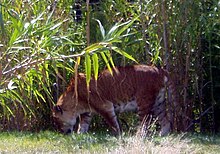Tigon
| Tigon | |
|---|---|

| |
| Tigon at National Zoo & Aquarium in Canberra, Australia | |
| Scientific classification | |
| Domain: | Eukaryota |
| Kingdom: | Animalia |
| Phylum: | Chordata |
| Class: | Mammalia |
| Order: | Carnivora |
| Suborder: | Feliformia |
| Family: | Felidae |
| Subfamily: | Pantherinae |
| Genus: | Panthera |
| Species: | |
The tigon is a hybrid offspring of a male tiger (Panthera tigris) and a female lion, or lioness (Panthera leo).[1] They exhibit visible characteristics from both parents: they can have both spots from the mother (lions carry genes for spots – lion cubs are spotted and some adults retain faint markings) and stripes from the father. Any mane that a male tigon may have will appear shorter and less noticeable than a lion's mane and is closer in type to the ruff of a male tiger.
Tigons do not exceed the size of their parent species because they inherit growth-inhibitory genes from both parents, but they do not exhibit any kind of dwarfism or miniaturization; they often weigh around 180 kg (400 lb). It is distinct from the liger, which is a hybrid of a male lion and a female tiger, often weighing from 320 kg (710 lb) to 550 kg (1,210 lb). [citation needed]
Fertility
[edit]Ligers and tigons were long thought to be sterile; in 1943, however, a 15-year-old hybrid between a lion and a tiger was successfully mated at the Munich Hellabrunn Zoo. The female cub was then raised to adulthood.[2] Like the liger, male tigons are sterile while the females are fertile.
At the Alipore Zoo in India, a tigoness named Rudhrani, born in 1971, was successfully mated to a male Asiatic lion named Debabrata. The rare, second-generation hybrid was called a litigon. Rudhrani produced seven litigons in her lifetime. Some of these reached impressive sizes - a litigon named Cubanacan weighed at least 363 kg (800 lb), stood 1.32 m (4 ft 4 in) at the shoulder, and was 3.5 m (11 ft) in total length.[3]
Reports also exist of the similar titigon, resulting from the cross between a female tigon and a male tiger. Titigons resemble golden tigers, but with less contrast in their markings. A tigoness born in 1978, named Noelle, shared an enclosure in the Shambala Preserve with a male Siberian tiger called Anton, due to the keepers' belief that she was sterile. In 1983 Noelle produced a titigon named Nathaniel. As Nathaniel was three-quarters tiger, he had darker stripes than Noelle and vocalized more like a tiger, rather than with the mix of sounds used by his mother. Being only about quarter-lion, Nathaniel did not grow a mane. Nathaniel died of cancer at the age of nine years old. Noelle also developed a severe cancer that killed her not long after she was diagnosed.[citation needed]
Coexistence of parental species
[edit]As with the liger, the tigon is found only in captivity,[2] because the habitats of the tiger and lion do not overlap. In the past, however, the Asiatic lion did coexist with the Bengal tiger in the wilderness of India, besides occurring in countries where the Caspian tiger had been, such as Iran and Turkey.[4][5] In India, there is a plan to shift some lions from their current home of the Gir Forest to Kuno Wildlife Sanctuary, which has some tigers,[6] but it has not been implemented as of December 2017, perhaps due to political reasons, as the Gujarat state government does not want any other state to have lions in the forests.[7][8][needs update]
See also
[edit]- Liger
- Liliger
- Carl Hagenbeck
- Felid hybrid
- Leopon
- Hybrid growth disorders
- List of portmanteaus
- Maltese tiger
- Panthera hybrid
References
[edit]- ^ Techné v6n3 – Patenting and Transgenic Organisms: A Philosophical Exploration. Scholar.lib.vt.edu. Retrieved on 17 September 2013.
- ^ a b Guggisberg, Charles Albert Walter (1975). Wild Cats of the World. New York: Taplinger Publishing. ISBN 0795001282.
- ^ The litigon rediscovered. www.natureasia.com. Retrieved on 22 July 2017.
- ^ Pocock, R. I. (1939). The Fauna of British India, including Ceylon and Burma. Mammalia. – Volume 1. Taylor and Francis Ltd., London. Pp. 199–222.
- ^ Heptner, V. G.; Sludskij, A. A. (1992) [1972]. Mlekopitajuščie Sovetskogo Soiuza. Moskva: Vysšaia Škola [Mammals of the Soviet Union. Volume II, Part 2. Carnivora (Hyaenas and Cats)]. Washington DC: Smithsonian Institution and the National Science Foundation. pp. 1–732.
- ^ Johnsingh, A.J.T. (2006). "Kuno Wildlife Sanctuary ready to play second home to Asiatic lions?". Field Days: A Naturalist's Journey Through South and Southeast Asia. Hyderabad: Universities Press. pp. 126–138. ISBN 8173715521.
- ^ "Tired of Gujarat reluctance on Gir lions, MP to release tigers in Kuno". Times of India. 5 December 2017. Retrieved 27 January 2018.
- ^ "Stalemate on translocation of Gir lions Kuno Palpur in Madhya Pradesh to be used as tiger habitat now". Hindustan Times. 7 December 2017. Retrieved 27 January 2018.
External links
[edit]- Detailed Information of hybrid big cats.
- Liger. snopes.com.
- Questions about Animals. Gk12.iastate.edu.
